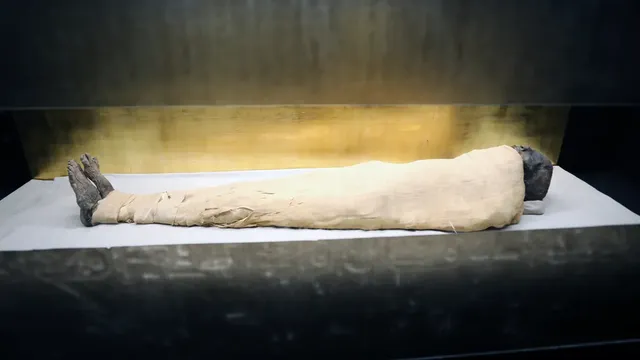Archaeologists have announced the discovery of the first tomb of a pharaoh in Egypt since Tutankhamun's first such was found more than 100 years ago.
The resting place of Thutmose II, who ruled some 3,500 years ago, was discovered in the western part of Luxor, which is known as the Valley of the Kings and where Tutankhamun was also buried in 1922.
The tomb's original entrance and its main corridor were discovered in 2022, but continued excavations at the site have found clues pointing to the pharaoh.
Dr Mohammed Ismail Khaled, secretary-general of Egypt's Supreme Council of Antiquities, said fragments of vessels bore inscriptions identifying Tuthmosis II as a "deceased king", along with the name of his wife Hatshepsut.
However, Tuthmosis' remains were discovered in the 19th century not far from the tomb. Archaeologists suggest that the mummy was probably moved centuries after the tomb was looted.
It was found in a poor state of preservation due to its exposure to flooding shortly after the king's death, which resulted in chunks of mortar falling from the interior.
The building includes a corridor with a floor covered with a layer of white plaster leading to the burial chamber in the main corridor of the tomb, where the floor level is about one and a half metres higher than the floor of the chamber itself.
Archaeologists also found remains of blue inscriptions and yellow celestial stars, as well as decorations and paragraphs from the religious book "IImydwat", which was placed in the tomb of the kings.
Thutmose II was the fourth pharaoh of Egypt's Eighteenth Dynasty, and his reign is thought to have lasted 13 years from 1493 to 1479 BC, or just 3 years from about 1482 to 1479 BC. He died at the age of 30.
Egypt's Eighteenth Dynasty, however, ruled for more than 200 years.
Archaeologists note that the tomb of Tuthmosis is the last of the lost kings of this era, but is considered less important compared to his father Tuthmosis I, his son Tuthmosis III, and his wife Queen Hatshepsut.
Thutmose I was the first pharaoh whose tomb was carved in the Valley of the Kings. While Tuthmosis III is known as the "Napoleon of Egypt" for his conquests and expansionism.
Hatshepsut, on the other hand, became famous for being a female pharaoh, but she also expanded trade and commissioned many building projects.
King Thutmose II, however, is known for putting down a rebellion in Nubia and leading armies to stop rebels in the Levant.
The burial structure was discovered in the Thebes Mountains, located about 1.4 miles from the "Valley of the Kings" area.
Archaeologists believe the tomb belonged to the wife of Tuthmosis' son because of its proximity to the tomb of Queen Hatshepsut, who was also his half-sister.
The secretary-general of the Supreme Council of Antiquities described this discovery as one of the most important archaeological discoveries in recent years, as the artifacts found there are an important addition to the history of the archaeological field and the reign of King Tutmoses II, archaeologists said.
They also note that their excavations uncovered the first funerary furniture of this king, unlike Tut, whose tomb was filled with 5,000 items.
On November 4, 1922, Carter's group discovered steps leading to Tutankhamun's tomb and spent several months cataloging the antechamber.
In February of the following year, the team opened the burial chamber and discovered the sarcophagus.
The tomb is believed to be one of the most lavish discovered in history, filled with precious objects to aid the young pharaoh in his journey to the afterlife.
The hoard of grave goods included funerary shoes of pure gold, statues, games and strange animals.
The small size of Tutankhamun's burial chamber, given its place in Egyptian history, has puzzled experts for years.
It took Carter and his team 10 years to clear the tomb of treasures.
The boy-king was an Egyptian pharaoh of the 18th dynasty and ruled between 1332 BC and 1323 BC.
He was the son of Akhenaten and took the throne at the age of nine or ten.
When Tut became king, he married his half-sister Ankhenpaaten.
He died at about the age of 18, and the cause of his death is unknown.
However, the young king was plagued by health problems due to his parents being brother and sister. | BGNES

 Breaking news
Breaking news
 Europe
Europe
 Bulgaria
Bulgaria







